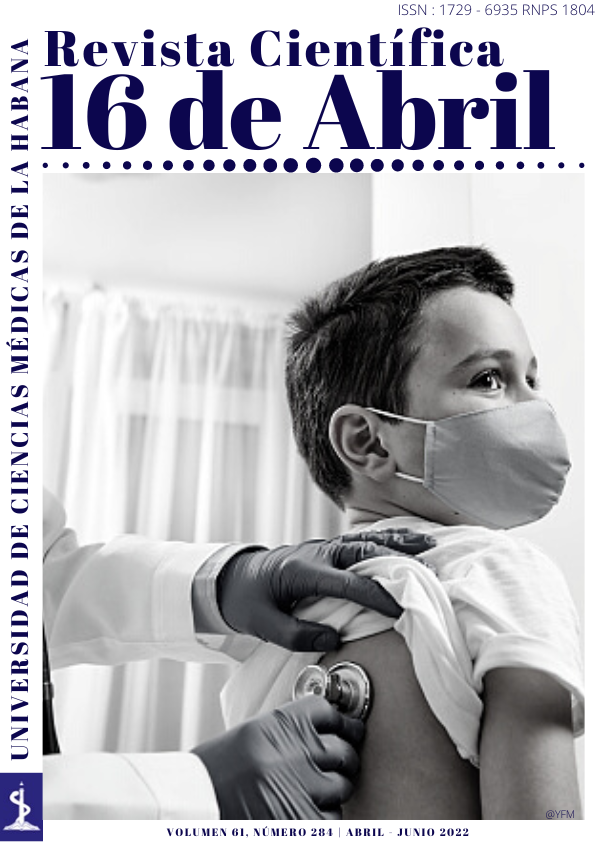Characterization of older adults treated in the emergency service of the “Mártires del Corynthia” Polyclinic
Keywords:
Elderly, Quality of life, Risk factor.Abstract
Introduction: aging begins when the body reaches its maximum functional capacity, it is a heterogeneous and irreversible process that represents a great challenge for socio-sanitary services worldwide.
Objective: to characterize the elderly treated in the emergency service of the “Mártires del Corynthia” Polyclinic.
Methods: an observational, descriptive and cross-sectional investigation was carried out in the emergency service of the "Mártires del Corynthia" Polyclinic from January to March 2022. The universe was made up of 130 adults over 60 years of age, who agreed to participate in research; fully worked. Descriptive statistics were used.
Results: the ages between 70 and 79 years (44.6%) and the female sex (77.7%) predominated, as well as the twelfth grade of schooling (28.5%) and the elderly who lived with other people (87 .7%). Arterial hypertension was the most frequent disease present in 86 patients. Of those surveyed, 108 did not exercise, 86 did not drink and 78 did not smoke. Most of the people who drank did so occasionally (84.1%), while those who smoked more frequently consumed less than 10 cigarettes per day (44.2%).
Conclusions: the characterization of the elderly, as a comprehensive geriatric assessment, allows to treat the problems in the elderly with efficiency and effectiveness. Patients older than 70 years and females predominated in the population. Most of them had a twelfth grade education and a high percentage lived with another person.
References
2. Savigne Echemendía J, Pérez Ramos J, Gonzáles Pérez Y. El adulto mayor en Cuba y la calidad de vida. Rev Observatorio de las Ciencias Sociales en Iberoamérica. [Internet]. 2021 [citado 4/0/2022]; 11(6). Disponible en: https://www.eumed.net/uploads/articulos/2d51238e574f7d70c1bfab9629fa8b8c.pdf
3. Martínez Pérez TJ, Gonzáles Aragón CM, Castellón León G, González Aguilar B. El envejecimiento, la vejez y la calidad de vida:¿éxito o dificultad? Rev. Finlay [Internet]. 2018 [citado 5/05/2022]; 8(1):59-65. Disponible en: http://scielo.sld.cu/scielo.php?script=sci_arttext&pid=S2221-24342018000100007&Ing=es&nrm=iso
4. Instituto de Prevención Social. Mejorar la calidad de vida y tener un envejecimiento saludable. Boletín informativo No.144. [Internet]. 2017 [citado 4 mayo 2022]; 142. Disponible en: https://portal.ips.gov.py/sistemas/ipsportal/noticia.php?cod=507
5. Instituto Nacional de Estadisticas Chile. Resultados Definitivos CENSO 2017. [Internet] Chile: Instituto Nacional de Estadisticas; 2018 [citado 4 mayo 2022]. Disponible en: https://www.gob.cl/noticias/resultados-finales-censo-2017-para-2050-se-proyecta-una-poblacion-de-216-millones-de-personas-en-chile/
6. Chuquipoma-Quispe LI, Lama-Valdivia JE, De la Cruz-Vargas JA. Factores asociados al síndrome de fragilidad en adultos mayores que acuden a consulta externa de Geriatría del Hospital Nacional Hipólito Unanue, Lima-Perú. Acta Med Peru. [Internet]. 2020 [citado 4 mayo 2022]; 37(1):267-73. Disponible en: http://www.scielo.org.pe/pdf/amp/v36n4/a04v36n4.pdf
7. García Quiñones R, Alfonso León A. El Envejecimiento en Cuba. Trabajo y Justicia Social [Internet]. La Habana: Centro de estudios demográficos Universidad de La Habana, 2020 [citado 4 mayo 2022] Disponible en: http:// http://library.fes.de/pdf-files/bueros/fescaribe/17127.pdf
8. Centro de estudios de población y desarrollo. El Envejecimiento de la Población. Cuba y sus territorios 2020. [Internet] La Habana: Centro de estudios de la población y desarrollo; 2021 [citado 4 mayo 2022]. Disponible en: http://www.onei.gob.cu/node/13821
9. Ministerio de Salud Pública. Dirección de Registros Médicos y Estadísticas de Salud. Anuario Estadístico de Salud 2020. [Internet] La Habana, 2021 [citado 21/01/2021]. Disponible en: https://files.sld.cu/bvscuba/files/2021/08/Anuario-Estadistico-Espa%C3%B1ol-2020-Definitivo.pdf
10. Gonzáles Fernández Y, Ramírez Pérez AR, Valdés Garrido YA, Cárdenas González L. Características sociodemográficas y evaluación funcional del adulto mayor. [Internet] Cuba: Universidad de Ciencias Médicas de Cienfuegos. Facultad “Dr. Raúl Dorticós Torrado”; 2019 [citado 4 mayo 2022]. Disponible en: https://jimsmedica.com/wp-content/uploads/2019/05/20_EVALUACION-FUNCIONAL-DEL-ADULTO-MAYOR.pdf
11. Baró Bouly T, Fernández Hernández M, Milanés Gonzáles T, Morlote Castañeda Y, Duany Rodríguez L. Acciones educativas para mejorar la calidad de vida en adultos mayores. Rev Inf Cient [Internet]. 2017 [citado 15 Jun 2022]; 96(5). Disponible en: http://www.revinfcientifica.sld.cu/index.php/ric/article/view/1739
12. Cano-Gutiérrez C, Borda MG, Reyes-Ortiz C, Arciniegas AJ, Samper-Ternent R. Evaluación de factores asociados al estado funcional en ancianos de 60 años o más en Bogotá, Colombia. Biomédica [Internet]. 2017 [citado 15 de junio de 2022]; 37(Sup1):57-5. Disponible en: https://revistabiomedica.org/index.php/biomedica/article/view/3197
13. Valdés-Fernández L, Fernández-Concepción M, Valdés-Jiménez L, Montes-Bermúdez A. Caracterización de los ancianos frágiles del Policlínico Universitario Cerro en el periodo 2017-2018. Medimay [Internet]. 2019 [citado 15 Jun 2022]; 26(2):[aprox. 13 p.]. Disponible en: http://revcmhabana.sld.cu/index.php/rcmh/article/view/1409
14. lanya Chipana JS. Capacidad Funcional del Adulto Mayor que asiste a consultorios de Medicina General del Hospital Huayacán, Lima, Perú, 2019. [Internet] Perú: Universidad Ricardo Palma; 2019 [citado 4 mayo 2022] Disponible en: https://repositorio.urp.edu.pe/bitstream/handle/20.500.14138/2707/SENF_T030_46923592_T%20%20%20ALANYA%20CHIPANA%20JENNIFER%20SUSAN.pdf?sequence=1
15. Wanden-Berghe C. Valoración geriátrica integral. Hospital a Domicilio [Internet]. 2021 [citado 16 de junio de 2022]; 5(2):115-24. Disponible en: https://www.revistahad.eu/index.php/revistahad/article/view/136
16. Hernández López M. Valoración Geriátrica en Primer Nivel de Atención. Rev Ocronos. [Internet] 2021 [citado 4 mayo 2022];IV(2): 85.Disponible en: https://revistamedica.com/valoración-geriatrica-primer-nivel-atencion/
17. Ruiz-Álvarez J, Llanes-Torres HM, Perdomo-Jorge JM, Santamaría-Rodríguez S. Caracterización de ancianos frágiles en consultorios del Médico de Familia. Medimay [Internet].2016 [citado 05/05/2022]; 23(1):[aprox. 11 p.]. Disponible en: http://www.medimay.sld.cu/index.php/rcmh/article/view/923
18. González-Rodríguez R, Cardentey-García J, Hernández-Díaz D, Rosales-Álvarez G, Jeres-Castillo C. Comportamiento de la fragilidad en adultos mayores. Archivo Médico Camagüey [Internet]. 2017 [citado 05/05/2022]; 21(4):[aprox. 11 p.]. Disponible en: http://revistaamc.sld.cu/index.php/amc/article/view/5018
19. González Rodríguez R, Martínez Abreu J. Un acercamiento clínico-epidemiológico a la fragilidad en adultos mayores. Rev Med Electrón. [Internet]. 2018 [citado 15/05/2022]; 40(4):1274-1278. Disponible en: http://scielo.sld.cu/scielo.php?script=sci_arttext&pid=S1684-18242018000400034&lng=es.
20. Bonet Gorbea M, Varona Pérez P. III Encuesta Nacional de Factores de Riesgo y Actividades Preventivas de Enfermedades No Transmisibles. Cuba 2010-2011. [Internet] La Habana: Editorial Ciencias Médicas; 2014 [citado 04/05/2022].Disponible en: http://www.ecimed.sld.cu
21. Ortiz PJ, Varela LF, Tello T, Mas G. Características antropométricas asociadas a fragilidad en adultos mayores sin deterioro funcional que viven en comunidad. Rev Soc Peru Med Interna [Internet]. 2017 [citado 05/05/2022]; 30(2):69-70. Disponible en: https://www.researchgate.net/publication/319141377_Caracteristicas_antropometricas_asociadas_a_fragilidad_en_adultos_mayores_sin_deterioro_funcional_que_viven_en_comunidad
22. ONEI. Encuesta Nacional de Envejecimiento de la Población Enero 2017. [Internet]. La Habana, 2017 [citado 04/05/2022]. Disponible en: http://www.onei.gob.cu/node/14725
Downloads
Published
How to Cite
Issue
Section
License
Those authors who have publications with this journal, accept the following terms:
The authors will retain their copyright and guarantee the journal the right of first publication of your work, which will be under a Creative license Commons Attribution-NonCommercial-ShareAlike 4.0 International . (CC BY-NC-SA 4.0).
The authors may adopt other non-exclusive license agreements for the distribution of the published version of the work (eg:deposit it in an institutional telemat








